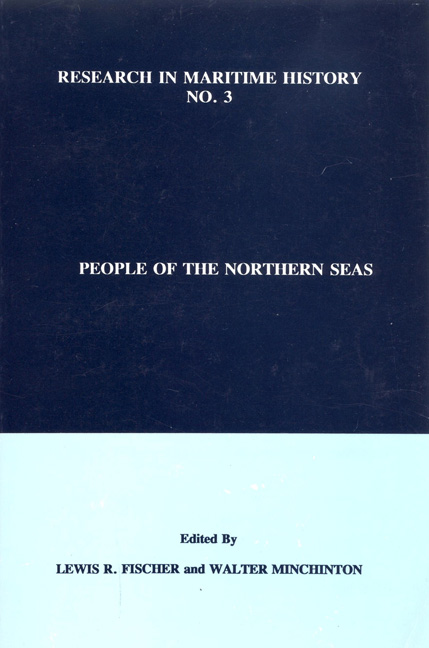Book contents
- Frontmatter
- Contents
- About the Editors
- Contributors
- General Introduction
- “Une Petite Republique” in Southwestern Newfoundland: The Limits of Imperial Authority in a Remote Maritime Environment”
- “Changes in Aleut Communities Following Russian Contact”
- “Five Years Before the Mast: Observations on the Conditions of Maritime Labour in Finland and Elsewhere”
- “Expressions of Longing, Sources of Anxiety? The Significance of Contacts with Home for Finnish Sailors in London and Hull in the Late Nineteenth Century”
- “Death of a Merchant”
- “St. Petersburg's Bills of Exchange in the Russian Economy of the Eighteenth Century”
- “Shipowners and Iron Sailing Ships: The First Twenty Years, 1838-1857”
- “The Growth of Norwegian Shipbroking: The Practices of Fearnley and Eger as a Case Study, 1869-1914”
- “Captain John Deane: Mercenary, Diplomat and Spy”
- “Her Majesty's Coastguard”
- “Coastal Life, ‘Nordic Culture’ and Nation State: Reflections on the Formation of the Nation State and Maritime History”
“Shipowners and Iron Sailing Ships: The First Twenty Years, 1838-1857”
- Frontmatter
- Contents
- About the Editors
- Contributors
- General Introduction
- “Une Petite Republique” in Southwestern Newfoundland: The Limits of Imperial Authority in a Remote Maritime Environment”
- “Changes in Aleut Communities Following Russian Contact”
- “Five Years Before the Mast: Observations on the Conditions of Maritime Labour in Finland and Elsewhere”
- “Expressions of Longing, Sources of Anxiety? The Significance of Contacts with Home for Finnish Sailors in London and Hull in the Late Nineteenth Century”
- “Death of a Merchant”
- “St. Petersburg's Bills of Exchange in the Russian Economy of the Eighteenth Century”
- “Shipowners and Iron Sailing Ships: The First Twenty Years, 1838-1857”
- “The Growth of Norwegian Shipbroking: The Practices of Fearnley and Eger as a Case Study, 1869-1914”
- “Captain John Deane: Mercenary, Diplomat and Spy”
- “Her Majesty's Coastguard”
- “Coastal Life, ‘Nordic Culture’ and Nation State: Reflections on the Formation of the Nation State and Maritime History”
Summary
The nineteenth-century maritime world was swept by a technological revolution as iron and steam replaced wood and wind. Although the transformation was sufficiently swift to be called “revolutionary,” it nevertheless took more than a century. Moreover, there was no clear-cut shift from wooden sailing vessels to iron steamships. With hindsight, the secular trend is intelligible: steam and iron made steady inroads, ultimately gaining total ascendancy. In the short-run, however, the metamorphosis was more complex, mixing sail and steam and wood and iron. These took various forms: amalgams of power—steam vessels with sails and sailing vessels with auxiliary engines-and combinations of materials—“composite vessels” utilising wood and iron. In addition, there were mergers of old and new forms of power and materials. Until the 1860s wooden steamers were significant, and from the late 1830s iron sailing ships were built. Until almost the end of the nineteenth century, the new was neither technically perfected nor wholly proven, and the old was not entirely inferior. In addition, the characteristics of various trades ensured that the introduction of new technologies was gradual.
This paper is concerned with one facet of mixed technologiesiron sailing vessels during the first twenty years or so of their existence— and the response of shipowners to this advance. Arguably, iron sailing vessels represented the outstanding form of mixed technology. While wooden steamships were significant until mid-century, they declined rapidly in importance thereafter. Composite vessels were never of any great account in terms of tonnage built and first registered in the United Kingdom and became irrelevant after 1870. Although doomed to eventual disappearance, the iron sailing vessel proved highly viable. Indeed, it was preferred to its wooden counterpart by many operators during what G.S. Graham termed the “ascendancy of the sailing ship.” In terms of tonnage of sailing ships built and first registered in the U.K. each year, iron first exceeded wooden sail in 1868 and continuously dominated from 1873 to 1890. In 1875, when total sail tonnage built and first registered totalled 241,600 tons-a figure only marginally surpassed in three years between 1787 and 1914-iron vessels comprised 198,800 tons, almost five times the tonnage of wood.3 As long as sail remained competitive, the iron sailing vessel was of considerable significance.
- Type
- Chapter
- Information
- People of the Northern Seas , pp. 115 - 134Publisher: Liverpool University PressPrint publication year: 1992



